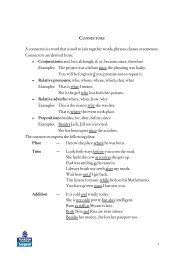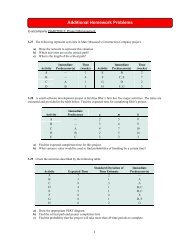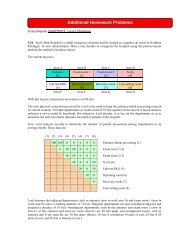The Economy at Full Employment - Pearson
The Economy at Full Employment - Pearson
The Economy at Full Employment - Pearson
Create successful ePaper yourself
Turn your PDF publications into a flip-book with our unique Google optimized e-Paper software.
118<br />
CHAPTER 7 (22)<br />
FIGURE 7.8<br />
Short Answer Problem 7<br />
FIGURE 7.9<br />
Short Answer Problem 7<br />
Real GDP (trillions of 1996 dollars)<br />
15<br />
13<br />
11<br />
9<br />
7<br />
a<br />
b<br />
PF 1<br />
PF 0<br />
Real wage r<strong>at</strong>e (1996 dollars per hour)<br />
21<br />
14<br />
7<br />
LS<br />
LD 0<br />
LD 1<br />
200 300 400<br />
Labor (billions of hours per year)<br />
100<br />
200 300 400<br />
Labor (billions of hours per year)<br />
labor curve has shifted rightward, from LD 0 to<br />
LD 1 . (Your figure does not need to look exactly<br />
like Figure 7.9, as long as the labor demand curve<br />
has shifted rightward.) As a result, the equilibrium<br />
quantity of employment increases, to 300 billion<br />
hours, and the equilibrium real wage r<strong>at</strong>e rises, to<br />
$21 per hour in the figure.<br />
GDP changes for two reasons: First, the production<br />
function has shifted upward, so even if employment<br />
did not change, GDP would increase. But, employment<br />
does increase. Thus as Figure 7.8 demonstr<strong>at</strong>es,<br />
GDP increases from $7 trillion to $12<br />
trillion as the economy moves from point a on production<br />
function PF0<br />
to point b on production<br />
function PF 1 .<br />
You’re the Teacher<br />
1. “Well the things you mentioned, money, recessions,<br />
and so on are important and when I flip through<br />
the book I see th<strong>at</strong> we’ll get to them a little l<strong>at</strong>er in<br />
the class. But they are not the only really important<br />
macroeconomic topics. I mean, one of the really<br />
important topics is economic growth, how rapidly<br />
our economy grows. And it’s this topic th<strong>at</strong> this<br />
chapter is concerned about.<br />
“Look, here’s how I see it. We want to know how<br />
fast our economy can grow and wh<strong>at</strong> we can do to<br />
make sure th<strong>at</strong> it grows <strong>at</strong> the best speed possible,<br />
right? Well, economic growth basically depends on<br />
two things: the resources our n<strong>at</strong>ion has and the<br />
technology we can use. Well, one of the most important<br />
resources is labor and this chapter is focusing<br />
on th<strong>at</strong>. This chapter helped me understand<br />
wh<strong>at</strong> factors change the equilibrium amount of labor,<br />
like the productivity growth. I mean, productivity<br />
has to be important because it not only<br />
increases the demand for labor and so increases the<br />
amount of labor th<strong>at</strong> will be employed, but it also<br />
increases our real wages.<br />
“And look, I’ve been talking with our teacher again<br />
and our teacher said th<strong>at</strong> this chapter and the next<br />
two concentr<strong>at</strong>e on economic growth. This chapter<br />
talks about one resource, labor. <strong>The</strong> next covers another<br />
resource, capital. And the one after th<strong>at</strong> puts<br />
all this together with a discussion of technology. So,<br />
this chapter is part of an important group.<br />
“So, don’t get upset because we aren’t talking about<br />
money or recessions or other stuff yet. Be p<strong>at</strong>ient;<br />
we’ll get there. But in the meantime let’s settle back<br />
and learn all about economic growth!”


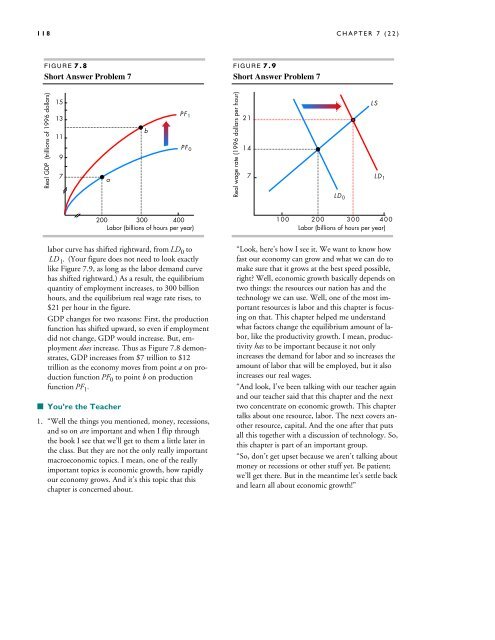




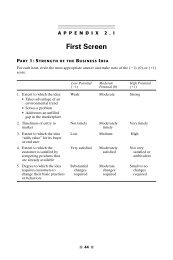
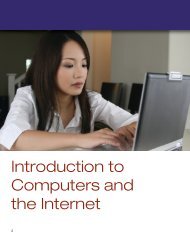




![[Productnaam] Marketingplan - Pearson](https://img.yumpu.com/26285712/1/190x132/productnaam-marketingplan-pearson.jpg?quality=85)
